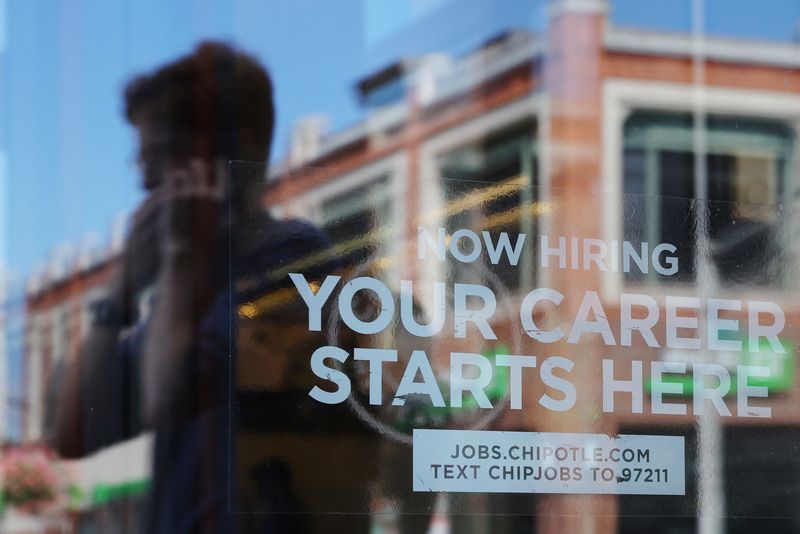By Lucia Mutikani
WASHINGTON (Reuters) – U.S. job growth likely slowed to still-healthy levels in December while the unemployment rate held steady at 4.2%, confirming the Federal Reserve’s cautious approach to rate cuts this year.
The Labor Department’s closely watched jobs report on Friday is unlikely to be marred by the weather and strike distortions that prevailed in October and November.
The labor market would end the year on solid footing, although fears are growing that President-elect Donald Trump’s promises to impose or sharply increase tariffs on imports and deport millions of undocumented immigrants could hurt momentum.
Those concerns were evident in the minutes of the Federal Reserve’s Dec. 17-18 monetary policy meeting released Wednesday, which said: “Most participants noted that … the Committee may proceed cautiously in considering further cuts. “
“The labor market is no longer as tight as it was after the pandemic, but it is still strong by historical standards,” said Sevin Yeltekin, a macroeconomist and dean of the Simon Business School at the University of Rochester. “If we can avoid a sharp increase in tariffs and immigration policies that burden companies that rely on both skilled and seasonal talent, companies will continue to create jobs.”
A Reuters poll of economists showed nonfarm payrolls likely rose by 160,000 jobs last month after rising by 227,000 in November, following heavy disruption from hurricanes and strikes. It is estimated that 120,000 to 200,000 new jobs were created.
Without revisions to October and November payroll numbers, that would mean the economy added 2.144 million jobs, or 179,000 jobs per month, in the final year of President Joe Biden’s term. Around 3 million jobs were created in 2023.
Labor market resilience, driven largely by historically low layoffs, has boosted the economy by supporting consumer spending through higher wages. Average hourly wages are expected to rise 0.3%, after rising 0.4% in November. Annual wage growth remained unchanged at 4.0% in December.
After the central bank’s sharp rate hikes in 2022 and 2023, hiring has slowed significantly. The economy is growing well above the 1.8% pace that Fed officials consider a noninflationary growth rate.
NO HIRING PROTECTION AFTER THE ELECTION
Last month’s job gains were likely concentrated in non-cyclical industries such as healthcare and government, a pattern that prevailed for much of 2024. While business sentiment improved after Trump’s election victory on November 5 on hopes of tax cuts and less stringent measures given the regulatory environment, economists do not expect a surge in hiring.
There were also no signs in company surveys that companies were planning to increase their workforce.
“Although uncertainty has eased somewhat, tariffs and immigration policy are important unknowns,” said Andrew Husby, senior economist at BNP Paribas (OTC:) Securities. “After the 2016 election, a significant increase in net hiring did not occur until Congress passed major tax-cutting legislation.”
Despite the prevailing strength, potential warning signs lurk. The unrounded unemployment rate has been creeping up, rising to 4.246% in November, which was rounded down to 4.2%. In October it rose to 4.145%, rounded down to 4.1%.
“The rounded data underestimated the recent increase in the unemployment rate,” said Ernie Tedeschi, economics director at The Budget Lab at Yale. “The unemployment rate is now less than a hundredth of a percentage point away from its July 2024 level. The tight rounding of October and November…means that the risks surrounding the unemployment rate in December are biased to the upside rather than to the upside.”
A rise in the unemployment rate to 4.3% in July, from a five-decade low of 3.4% in April 2023, was key to the Fed continuing its monetary easing cycle with an unusually large half-percentage point rate cut in September initiated. Interest rate cuts of a quarter point followed in November and December, leaving the reference interest rate for overnight money in the range of 4.25% to 4.50%.
Last month, the Fed forecast just two quarter-point interest rate cuts this year, compared to the four it forecast in September. The key interest rate was raised by 5.25 percentage points in 2022 and 2023.
“As things stand, Fed officials appear to have reached an uncomfortable level of certainty about the labor market situation,” said Stephen Stanley, chief U.S. economist at Santander (BME:) US Capital Markets.
The government will revise the seasonally adjusted household survey data from which the unemployment rate is derived for the past five years. Economists expect minimal or no impact on the unemployment rate.

The easing of labor market conditions is underscored by a steady increase in the number of people who have permanently lost their jobs, as well as the average duration of unemployment since September, which reached a near three-year high of 10.5 weeks in November. This is consistent with the Vacancies and Workforce Turnover Survey, which shows that hiring rates have returned to levels seen at the start of the pandemic.
“So far, the increase in permanent job losses and duration of unemployment are not too concerning given the low layoff rate, but the trend for both bears watching,” said Nancy Vanden Houten, senior U.S. economist at Oxford Economics.





